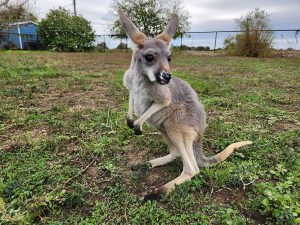About Red Kangaroos
Exploring the Fascinating World of Red Kangaroos
Welcome to our comprehensive guide about Red Kangaroos (Macropus), one of Australia’s most iconic and enchanting marsupials. In this detailed post, we’ll delve into the incredible world of Red Kangaroos, their unique characteristics, behavior, habitat, and the importance of conservation efforts to protect these magnificent creatures.

Table of Contents
- Introduction to Red Kangaroos
- Physical Characteristics
- Behavior and Social Structure
- Habitat and Range
- Diet and Feeding Habits
- Reproduction and Life Cycle
- Conservation Status
- How You Can Help
1. Introduction to Red Kangaroos
Red Kangaroos, often simply referred to as “Reds,” are the largest marsupials on Earth. They are found exclusively in Australia and have become an enduring symbol of the Australian Outback. These incredible creatures have captivated the world with their unique features, powerful leaping ability, and striking appearance.
2. Physical Characteristics
Red Kangaroos are known for their distinctive red or reddish-brown fur, with a white underside and pale facial markings. They possess long, muscular hind legs, which are perfectly adapted for hopping, allowing them to reach speeds of up to 40 miles per hour and cover great distances effortlessly.
3. Behavior and Social Structure
Red Kangaroos are typically solitary animals, although they can form loose social groups known as mobs. Males, or “boomers,” often display territorial behavior, particularly during the breeding season. Females, or “flyers,” have a more flexible social structure and often gather in larger groups. They communicate through various vocalizations and are known for their distinctive grunts.
4. Habitat and Range
These kangaroos are incredibly adaptable and can be found in a variety of habitats across Australia, from arid deserts to grassy plains and woodland areas. They have an extensive range and are well-suited to the harsh and unpredictable conditions of the Australian landscape.
5. Diet and Feeding Habits
Red Kangaroos are herbivores with a diet primarily consisting of grasses. Their specialized digestive system allows them to efficiently extract nutrients from fibrous plant material. They have a remarkable ability to survive in regions with limited water and food resources.
6. Reproduction and Life Cycle
Female Red Kangaroos are known for their unique reproductive system. They can delay the development of a fertilized embryo until environmental conditions are favorable for their young. Typically, a single joey is born, and it spends several months in the mother’s pouch before gradually venturing out. The bond between mother and joey is strong and enduring.
7. Conservation Status
Red Kangaroos are listed as a species of “Least Concern” by the International Union for Conservation of Nature (IUCN). However, like many wildlife species, they face threats such as habitat loss, climate change, and commercial harvesting. Conservation efforts are crucial to ensure their continued survival.
8. How You Can Help
- Support organizations dedicated to kangaroo conservation.
- Be responsible when visiting their natural habitats, respecting their space.
- Raise awareness about the importance of protecting native Australian wildlife.
In conclusion, Red Kangaroos are a symbol of Australia’s unique wildlife and an important part of the country’s natural heritage. Understanding and appreciating these magnificent marsupials can help ensure their preservation for future generations to enjoy.
Remember, Red Kangaroos are a vital part of the intricate ecosystems of the Australian Outback, and by learning more about them, you can contribute to their protection and conservation.
